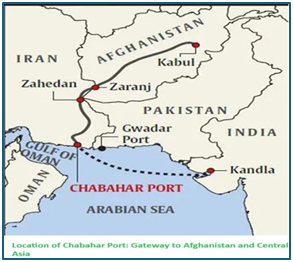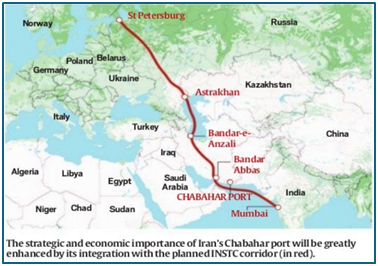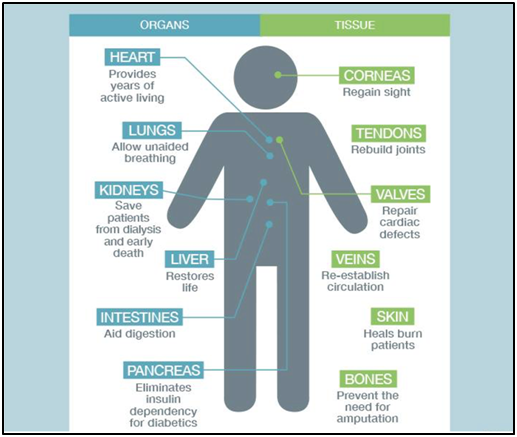Editorials & Articles : 14 May 2024

Why in news?
- India and Iran signed a long-term agreement covering Indian operations at the Chabahar port, eight years after concluding the general framework of cooperation for the port in Iran.
What’s in today’s article?
- Chabahar port
- Significance of Chabahar Port
- 10-year agreement for Chabahar port operation
Chabahar port
- About
- Chabahar is a deep-water port in Iran’s Sistan-Baluchistan province. It is the Iranian-port that is the closest to India.
- It is located in in south-eastern Iran, on the Gulf of Oman, providing easy and secure access for large cargo ships.
- It is Iran’s first deepwater port that puts the country on the global oceanic trade route map.
- Development of port
- An MoU for the development of Chabahar port by India was signed in May 2015. The contract was executed in May, 2016 during the visit of PM Modi to Iran.
- Current status
- India has so far supplied six mobile harbour cranes (two of 140-tonne and four of 100-tonne capacity) and other equipment worth $25 million.
- India Ports Global Ltd (IPGL has been operating Chabahar port through its wholly owned subsidiary, India Ports Global Chabahar Free Zone (IPGCFZ), since December 24, 2018.
- The port has handled more than 90,000 twenty-foot-equivalent units (TEUs) of container traffic and more than 8.4 million metric tonnes (MMT) of bulk and general cargo since then.
Significance of Chabahar Port
- Strategic significance to both Iran and India
- It can potentially help Tehran ward off the effect of Western sanctions.
- It offers New Delhi an alternative route that bypasses Pakistan in order to ensure access to Afghanistan and Central Asia.
- The port is partly intended to provide an alternative for trade between India and Afghanistan as it is 800 kilometres closer to the border of Afghanistan than Pakistan’s Karachi port.
- Pakistan does not allow India, land access for trade with Afghanistan and Central Asia.
- Humanitarian corridor
- The port has also facilitated the supply of humanitarian assistance, especially during the Covid-19 pandemic.
- Till date, a total of 2.5 million tonnes of wheat and 2,000 tonnes of pulses have been transshipped from India to Afghanistan through Chabahar port.
- In 2021, India supplied 40,000 litres of the environment friendly pesticide (malathion)through the port to Iran to fight locust attacks.
- Chabahar and International North-South Transport Corridor (INSTC)
- The INSTC, which was initiated by Russia, India, and Iran, is a multi-modal transportation route envisaged to link the Indian Ocean and Persian Gulf to the Caspian Sea via Iran, and onward to northern Europe via St Petersburg in Russia.
- The INSTC envisages the movement of goods:
- from Mumbai to Bandar Abbas in Iran by sea;
- from Bandar Abbas to Bandar – e- Anzali, an Iranian port on the Caspian Sea, by road;
- from Bandar-e-Anzali to Astrakhan, a Caspian port in the Russian Federation by ship; and
- onward to other parts of the Russian Federation and Europe by rail
- Hence, INSTC and Chabahar Port will complement each other for optimising Indian connectivity with Russia and Eurasia.
- Tool to strengthen India’s relation with Iran & Afghanistan
- This port has potential to herald a new age of trade, marine cooperation, and transshipment while boosting trilateral trade between India, Iran, and Afghanistan.
10-year agreement for Chabahar port operation – key highlights
- Agreement signed
- The long-term agreement was signed between Indian Ports Global Ltd. (IPGL) and Port and Maritime Organisation (PMO) of Iran, enabling operation of the Shahid-Behesti terminal.
- Funding
- IPGL will invest approximately $120 million in equipping the port.
- India has also offered a credit window equivalent to $250 million for mutually identified projects aimed at improving Chabahar-related infrastructure.
- Significance
- This agreement has cleared the pathway for bigger investments to be made in the port.
- The signing of long-term agreement got delayed due to some tricky issues, including arbitration.
- In the absence of long-term agreement, the two countries had concluded short-term leases.
- This agreement has cleared the pathway for bigger investments to be made in the port.

Why in news?
- The Geneva-based, United Nations-linked Global Alliance of National Human Rights Institutions (GANHRI) deferred the accreditation of the National Human Rights Commission-India (NHRC) for the second year in a row. This is the first time India’s status has been suspended for two years in a row, in 2023 and in 2024. The decision was taken during the meeting of the Sub Committee on Accreditation (SCA) on May 1, 2024. This decision could now affect India’s ability to vote at the Human Rights Council and some UNGA bodies.
What’s in today’s article?
- National Human Rights Commission (NHRC)
- Global Alliance for National Human Rights Institutions (GANHRI)
- NHRC-India accreditation status review
National Human Rights Commission (NHRC)
- About
- It is a statutory body established under the Protection of Human Rights Act, 1993. The Commission is the watchdog of human rights in the country.
- Composition of NHRC
-
- It is a multi-member body consisting of a chairperson and five members.
- The chairperson should be a retired chief justice of India or a judge of the Supreme Court.
- Members should be a serving or retired judge of the Supreme Court, a serving or retired chief justice of a high court and three persons (out of which at least one should be a woman) having knowledge or practical experience with respect to human rights.
- Appointment & Tenure
- The chairperson and members are appointed by the President on the recommendations of a six-member committee consisting of:
- Prime Minister as its head; Speaker of the Lok Sabha; Deputy Chairman of the Rajya Sabha; Leaders of the Opposition in both the Houses of Parliament; Central Home Minister
- The chairperson and members are appointed for the term of 3 years or till the age of 70 years, whichever is earlier.
- The chairperson and members are eligible for reappointment.
- The chairperson and members are appointed by the President on the recommendations of a six-member committee consisting of:
Global Alliance for National Human Rights Institutions (GANHRI)
- About
- It is an organisation affiliated to the UN High Commissioner for Human Rights.
- It is a global network of national human rights institutions (NHRIs) that works to promote and protect human rights.
- GANHRI represents 120 NHRIs from around the world.
- GANHRI’s mission is to unite, promote, and strengthen NHRIs to operate in line with the UN Paris Principles.
- Accreditation by the GANHRI
- Sub-Committee on Accreditation (SCA) reviews NHRIs every five years, and there is an appeal process for NHRIs to ensure greater transparency and due process.
- In a unique peer-review-based accreditation process, GANHRI ensures individual NHRIs’ compliance with internationally recognised standards – the Paris Principles – to ensure their independence, pluralism and accountability.
- The Paris Principles set out internationally agreed minimum standards that NHRIs must meet to be considered credible.
- The six principles require a country‘s human rights agency to be independent from the government in its structure, composition, decision-making and method of operation.
- An NHRI is reviewed by the SCA when –
- It applies for initial accreditation
- It applies for re-accreditation every five years
- The circumstances of the NHRI change in any way that may affect its compliance with the Paris Principles.
- NHRIs that are assessed as complying with the Paris Principles are accredited with ‘A status’, while those that partially comply are accredited with ‘B status’.
- This accreditation status affects a country’s ability to vote at the UN Human Rights Council and some UNGA bodies.
- India’s accreditation: India’s NHRC got ‘A’ status of accreditation for the first time in 1999, which it retained in 2006, 2011, and in 2017 after it was deferred for a year.
NHRC-India accreditation status review
On May 1, 2024, NHRC’s performance was to be reviewed in order to decide on the accreditation status.
- Observations made by SCA
- The committee’s latest report is still awaited. However, its previous report (2023 report) had cited a number of reasons for recommending the deferral. These included:
- Composition: lack of transparency in appointing members to the NHRC,
- appointment of police officers to oversee human rights investigations
- lack of gender and minority representation on the member panel.
- The NHRC’s ratings were put on hold in 2023 over these concerns
- The committee’s latest report is still awaited. However, its previous report (2023 report) had cited a number of reasons for recommending the deferral. These included:
- India’s stand
- GANHRI wanted India to make some structural changes and incorporate a few suggestions given by them. However, this was not possible at this time due to the ongoing general elections in India.
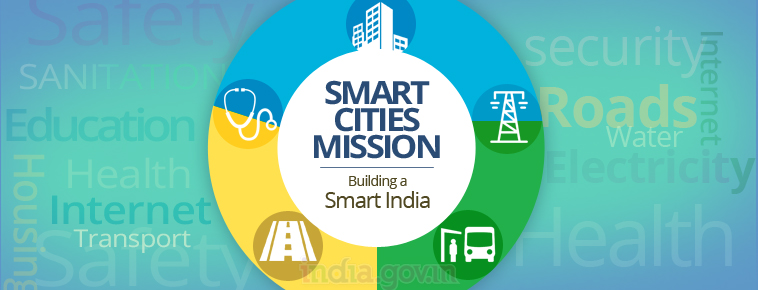
Why in News?
- In this year’s list of poll promises and accomplishments, the NDA-1 government’s flagship program – Smart Cities Mission (SCM), has taken a back seat.
What’s in Today’s Article?
- What is the Smart Cities Mission (SCM)?
- What are the Main Components of SCM?
- What are the Achievements of SCM?
- Some Success Stories of SCM
- What are the Criticisms of SCM?
What is the Smart Cities Mission(SCM)?
- It is a Centrally Sponsored Scheme of the Union Ministry of Housing and Urban Affairs (MoHUA), launched on 25 June, 2015.
- Its objective is to promote cities –
- To ensure a decent quality of life to their citizens through the application of ‘smart solutions’.
- To drive economic growth through comprehensive work on social, economic, physical and institutional pillars of the city.
- To drive sustainable and inclusive development.
- 100 cities were selected for five years under the mission, which did not clearly define a smart city.
- The Central Government will give financial support to the extent of Rs. 48,000 crores over 5 years i.e. on an average 100 crore per city per year.
- An equal amount on a matching basis is to be provided by the State/ULB.
- The mission that was to be completed in 2020, was given two extensions till June 2024.
What are the Main Components of SCM?
- The SCM had two main aspects:
- Area-based development consisting of three components [redevelopment (city renewal), retrofitting (city improvement), and green field projects (city extension)] and
- Pan-city solutions based on ICT.
- These further comprised some six categories that would include e-governance, waste management, water management, energy management, urban mobility, and skill development.
What are the Achievements of SCM?
- Around ₹2 lakh crore was kept aside for the mission, with public-private partnerships (PPP) an important driver of the same (though, not more than 5% has come through the PPP route).
- In order to make the mission effective, a business model of governance was adopted bypassing the existing models of city governance in the country.
- An SPV (special purpose vehicle) led by a bureaucrat or a representative of an MNC, and other major stakeholders was created and registered under the Companies Act.
- The SCM, with an allocation of ₹86,850 crore over eight years, has achieved an impressive completion rate of 83%.
- Participating cities have utilised ₹72,571 crore, focusing on 21 sectors including education, health, housing, water supply, solid waste management, and public transport.
- The most common feature across all cities – Integrated Command and Control Centers (ICCCs), enable monitoring and management of various urban functions.
- They have been instrumental in disaster response, flood monitoring, and traffic management.
Some Success Stories of SCM:
- Davanagere’s (Karnataka) Stormwater Drainage System:
- It successfully implemented a holistic stormwater drainage system, significantly reducing instances of flooding.
- This project exemplifies the mission’s effectiveness in addressing crucial urban challenges.
- Jabalpur’s (MP) Water Supply Enhancement:
- Jabalpur is set to provide 24×7 water supply to 2,000 households, showcasing the mission’s focus on improving essential services.
- However, challenges remain in retrofitting existing infrastructure with new technologies.
What are the Criticisms of SCM?
- The selection of 100 cities on a competitive basis and implementation of SCM was flawed, as the urbanisation in India is dynamic and not static like the West.
- The SCM became an exclusionary scheme wherein not more than 1% of a city’s geographical area was selected for development.
- The projects sanctioned under the SCM have seen a fall in the total outlay from the expected ₹2 lakh crore to ₹1,67,875 crore.
- This is 16% less than the projected capital flow in 100 cities.
- The SPV model designed for smart cities was not aligned with the 74th Constitutional Amendment, resulting in a top-bottom governance structure.
- In the name of executing smart city projects, there was displacement of people living in poorer localities. For example, street vendors.
- Another major consequence of the SCM has been enhanced urban flooding, because infrastructure projects dismantled water channels in some of the towns.
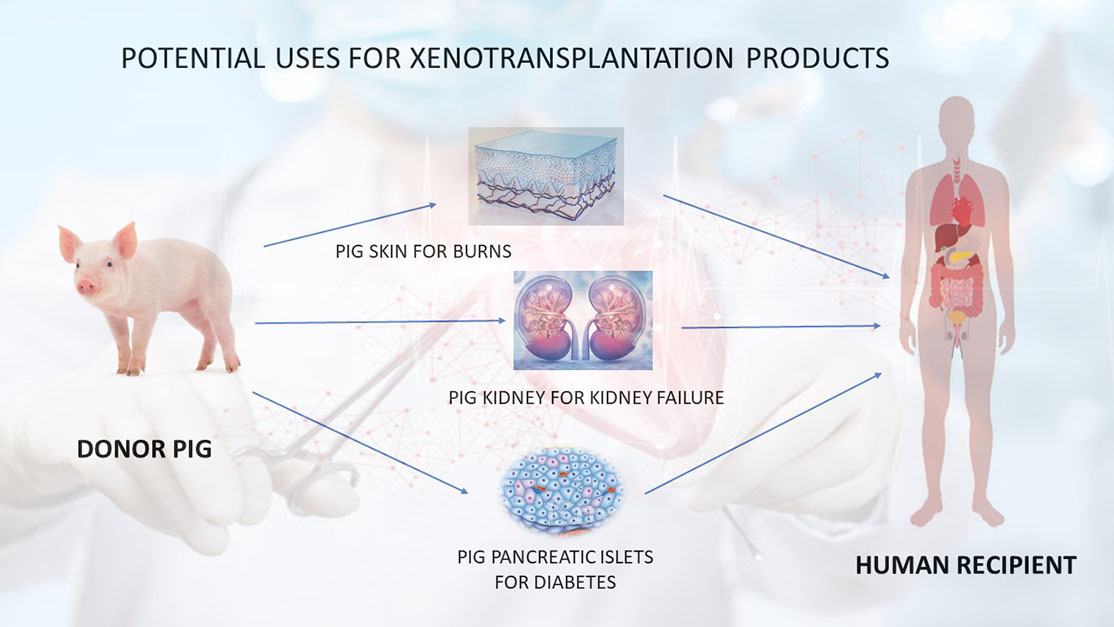
Why in the News?
- The first recipient of a modified pig kidney transplant passed away around two months after the surgery was carried out.
- Richard “Rick” Slayman had the transplant at Massachusetts, USA in March at the age of 62. Surgeons said they believed the pig kidney would last for at least two years.
What’s in Today’s Article?
- About Transplantation (Meaning, Human Transplantation)
- About Xenotransplantation (Meaning, Need, Why Pig’s Organs are Used, Etc.)
- News Summary
Transplantation:
- Transplantation is a surgical procedure in which tissue or an organ is transferred from one area of a person’s body to another area, or from one person (the donor) to another person (the recipient).
- In the last 50 years, transplantation has become a successful worldwide practice.
Human Transplantation:
- Human cells and tissues for transplantation can save lives or restore essential functions. For example:
- A corneal graft can restore sight in corneal blindness;
- The transplantation of haematopoietic stem cells can cure congenital or acquired diseases including leukaemia.
- The transplantation of a human heart valve often constitutes the best replacement situation and recipient patients do not require long term anti-coagulation therapy.
What is Xenotransplantation?
- Xenotransplantation involves the transplantation of nonhuman tissues or organs into human recipients.
- The development of xenotransplantation is driven by the fact that the demand for human organs for clinical transplantation far exceeds the supply.
- Scientists are still exploring the risks and benefits of xenotransplantation.
Why Pig’s Organsare Used for Xenotransplantation?
- Since the 1990s, researchers have attempted to use pigs as the source animal for xenotransplantation, and the pig is currently considered the most appropriate candidate species.
- Reasons for selecting the pig as a source animal include:
- Pig’s relatively large litter size and short maturation period,
- Its size and physiological similarity to humans,
- Low risk of xenozoonosis (an infectious disease transmitted from animal to human by transplantation), and
- Readily application of genetic engineering techniques to produce porcine organs that are resistant to rejection.
- Thanks to genetically modified pigs and immunosuppressive therapy, survival time results for xenografts have improved considerably in preclinical xenotransplantation models.
What is Immunosuppressive Therapy?
- Immunosuppressive therapy is a drug regimen that patients use to lower their bodies’ immune response.
- These drugs help doctors stop the immune system from overreacting and damaging transplanted organs and tissues.





